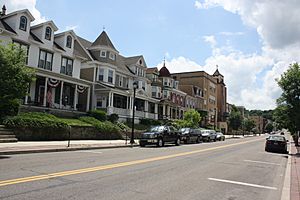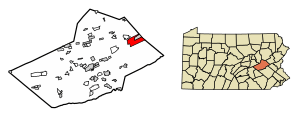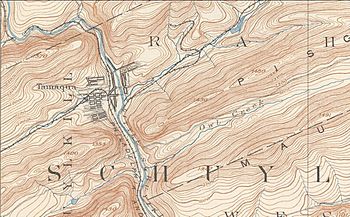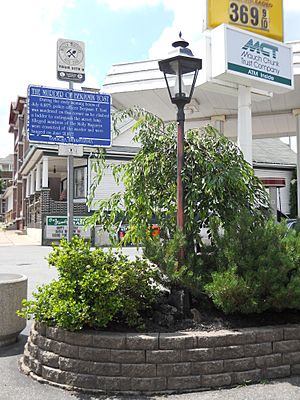Tamaqua, Pennsylvania facts for kids
Quick facts for kids
Tamaqua
tëmakwe
|
|
|---|---|
|
Borough
|
|
| Borough of Tamaqua | |

West Broad Street, Tamaqua, July 2013.
|
|
| Etymology: Corruption of Native American word "Tankamochkhanna" meaning "Little Beaver Stream" | |

Location of Tamaqua in Schuylkill County, Pennsylvania.
|
|
| Country | United States |
| State | Pennsylvania |
| County | Schuylkill |
| Incorporated | 1832 |
| Area | |
| • Total | 9.72 sq mi (25.17 km2) |
| • Land | 9.56 sq mi (24.77 km2) |
| • Water | 0.16 sq mi (0.40 km2) |
| Elevation | 870 ft (270 m) |
| Population
(2010)
|
|
| • Total | 7,107 |
| • Estimate
(2019)
|
6,664 |
| • Density | 696.93/sq mi (269.07/km2) |
| Demonym(s) | Tamaquan |
| Time zone | UTC-5 (EST) |
| • Summer (DST) | UTC-4 (EDT) |
| ZIP code |
18252
|
| Area code(s) | 570 and 272 (570 Exchanges: 668,952) |
| FIPS code | 42-76032 |
| School District | Tamaqua Area School District |

Tamaqua (pronounced tuh-MAH-qwah, Delaware: tëmakwe) is a borough in eastern Schuylkill County, Pennsylvania, United States. The borough is located in Central Eastern Pennsylvania's Southern Coal Region. It had a population of 7,107 as of the 2010 U.S. census.
Tamaqua was established from territory from West Penn and Schuylkill Townships. The borough is part of the Pottsville, PA Micropolitan Statistical Area.
Contents
Geography
Tamaqua is located in a valley basin at 40°47′55″N 75°57′59″W / 40.79861°N 75.96639°W (40.798600, -75.966498) situated within the Pennsylvania Southern Coal Region section of the Appalachian Mountains in the Schuylkill River drainage basin. Tamaqua's valley is just off the western end of the Pocono Mountains, just on the edge of the neighboring Lehigh watershed. Because of the dominant terrain the town is typical of medium towns in Ridge-and-valley Appalachians—low lands and flats were historically given over to business, rail transport, and industries, with dwellings located upon the slopes above.
According to the U.S. Census Bureau, the borough has a total area of 10.0 square miles (26 km2), of which, 9.8 square miles (25 km2) of it is land and 0.1 square miles (0.26 km2) (1.31%) of it is water. Three streams pass through Tamaqua. The Little Schuylkill River, lesser known by its earlier name, the Tamaqua River, runs through the town from the north through the gap separating the folds of what would be an unbroken ridgeline but are now the separated ridges known as Sharp Mountain on the west and Nesquehoning Mountain. Panther Creek, flows southwest from Lansford, 5 miles away, and joins the Little Schuylkill in Tamaqua. The Wabash Creek joins the Little Schuylkill from the west.
In the Tamaqua area, coal mining was a vital economic activity throughout the 20th century but with the diminished use of coal as a power plant fuel and the demise of steam powered traction, has since experienced a decline. The town also gained recognition as a railroad center. In addition, the 1885 Edison Electric Illuminating Co. of Tamaqua is said to have furnished the town with the nation's second incandescent municipal lighting system, a feat accomplished through the involvement of Thomas Edison.
The nearest city to Tamaqua is Hazleton, located just 12.5 miles north. Tamaqua is located 15 miles (24 km) east of Pottsville, 14 miles (23 km) southwest of Jim Thorpe, approximately 60 miles (97 km) south of Scranton, approximately 95 miles (153 km) northwest of Philadelphia, and approximately 100 miles (160 km) southwest of New York City.
Tamaqua's average elevation is 870 feet (270 m) above sea level. Elevations can reach up to 1,000 feet (300 m) above sea level.
Railroads
Until the late 1960s, Tamaqua was a hub of railroad activity, namely the Reading Company (RDG) and Lehigh & New England (LNE). A large rail yard existed in the southern part of town that actually extended through downtown; at one time eight tracks passed by the passenger station. An engine house, turntable, and car shop were located across the street from the passenger station in what is now the St. Luke's Medical Center parking lot. The collapse of the anthracite coal industry in the early 1960s, the Penn Central merger, and Hurricane Diane all led to the railroad's demise. Today, all that remains is a single track line through town operated by the Reading and Northern Railroad.
Transportation
The main highway in the borough, Pennsylvania Route 309, connects Tamaqua with Allentown and Philadelphia to the south and Hazleton and Wilkes-Barre to the north, continuing past there as PA Route 29 to the New York state line. Route 309 serves as a truck bypass for Interstate 476 since many placarded trucks are not allowed in the Lehigh Tunnel and as a route of choice for access to the region's operating coal mines and industrial parks. A second highway in the borough, U.S. Route 209, runs along Panther Creek and intersects with Route 309 in the borough. Route 209 runs for approximately 212 miles from Millersburg in Dauphin County to Ulster in Ulster County, New York. U.S. 209 also connects Tamaqua to nearby municipalities, including the Schuylkill County seat at Pottsville in the west and both Jim Thorpe and Lehighton to the east.
Tamaqua has a small rail yard, but its switching and geography makes it an important junction with tracks along both the Little Schuylkill River and others penetrating near the west-flowing Panther Creek and north into Hazleton. The town once hosted trackage of the Reading Railroad and the Lehigh Valley and New England Railroad.
Other highways near Tamaqua include Pennsylvania Route 54, Pennsylvania Route 443, Pennsylvania Route 895 and Pennsylvania Route 902, most of which connect the Tamaqua area to the Poconos, the Lehigh Valley, and South Central Pennsylvania. In addition, Interstates 81, 80, 476, and 78 are not far from the town.
Bus service is provided by Schuylkill Transportation System, Route 45 (Pottsville-McAdoo), and Fullington Trailways (intercity). Carbon County Community Transit provides bus service to Tamaqua along Lynx 3, which runs between Hometown and Nesquehoning via Tamaqua, Coaldale, Lansford, and Summit Hill on Wednesdays.
Demographics
| Historical population | |||
|---|---|---|---|
| Census | Pop. | %± | |
| 1840 | 465 | — | |
| 1850 | 3,080 | 562.4% | |
| 1860 | 4,919 | 59.7% | |
| 1870 | 5,960 | 21.2% | |
| 1880 | 5,730 | −3.9% | |
| 1890 | 6,054 | 5.7% | |
| 1900 | 7,267 | 20.0% | |
| 1910 | 9,462 | 30.2% | |
| 1920 | 12,363 | 30.7% | |
| 1930 | 12,936 | 4.6% | |
| 1940 | 12,486 | −3.5% | |
| 1950 | 11,508 | −7.8% | |
| 1960 | 10,173 | −11.6% | |
| 1970 | 9,246 | −9.1% | |
| 1980 | 8,843 | −4.4% | |
| 1990 | 7,943 | −10.2% | |
| 2000 | 7,124 | −10.3% | |
| 2010 | 7,107 | −0.2% | |
| 2019 (est.) | 6,664 | −6.2% | |
| Sources: | |||
As of the census of 2000, there were 7,174 people, 3,179 households, and 1,901 families residing in the borough. The population density was 729.9 people per square mile (281.8/km2). There were 3,602 housing units at an average density of 366.5 per square mile (141.5/km2). The racial makeup of the borough was 98.69% White, 0.18% African American, 0.08% Native American, 0.22% Asian, 0.25% from other races, and 0.57% from two or more races. Hispanic or Latino of any race were 1.30% of the population.
There were 3,179 households, out of which 24.8% had children under the age of 18 living with them, 43.9% were married couples living together, 11.9% had a female householder with no husband present, and 40.2% were non-families. 35.9% of all households were made up of individuals, and 19.9% had someone living alone who was 65 years of age or older. The average household size was 2.25 and the average family size was 2.93.
The borough's population consisted of 21.8% under the age of 18, 6.9% from 18 to 24, 28.4% from 25 to 44, 21.7% from 45 to 64, and 21.2% who were 65 years of age or older. The median age was 40 years. For every 100 females, there were 92.0 males. For every 100 females age 18 and over, there were 87.2 males.
The median income for a household in the borough was $27,899, and the median income for a family was $36,406. Males had a median income of $29,970 versus $20,637 for females. The per capita income for the borough was $15,752. About 11.1% of families and 14.9% of the population were below the poverty line, including 24.1% of those under age 18 and 11.3% of those aged 65 or over.
History
Tamaqua was settled in 1799 when Burkhardt Moser, alternatively Berkhard, accompanied by his son Jacob, born in 1790 and by John Kershner, built shelters and a sawmill at the confluence of the Little Schuylkill River and ‹See Tfd›Panther Creek, which is downtown Tamaqua today. According to property records, Moser had a partner named Houser, and together they owned 2,000 acres which Moser homesteaded. Moser built a log house at the base of dutch hill in 1801 for Mrs. Moser — who as it happens was the first adult to die and receive burial there in February 15, 1822; followed later in April that year by John Kersher.
Originally to be named Tuscarora, the name Tamaqua was chosen after it was realized that there already was a community named Tuscarora about four miles (6 km) to the west. Contrary to the meaning of the name presented above, the editor of The History of Schuylkill County wrote in 1881:
"The town was laid out from parts of West Penn and Schuylkill townships in 1829, at which time the population was about 150. The design was to name it Tuscarora, but some enterprising person arose too early in the morning for the pioneers and gave that Indian name to the village four miles west. As the waters of the Tamaqua, rechristened Wabash, the west branch of the Little Schuylkill, passed through the tract, it was decided to name the infant with the name of the creek, Tamaqua, which is Indian for `running water'."
That editor writes about the founding:
Mr. Moser was an industrious man, clearing the forest around his mill and laying out a farm, never dreaming that beneath his fields lay the great seams of coal, the mining of which was in future years to open employment to tens of thousands. February 15th, 1822, Mrs. Moser died. This was the first death of an adult person in the place. In April of the same year John Kershner passed away.
The first business relied upon to support the infant town was agriculture, which, with the manufacture of lumber, was the principal industry for twenty years. For this purpose the elevated sloping land east of the borough, as well as that upon the immediate north, was chosen by Moser.
In 1817 anthracite coal was discovered by Berkhard Moser and his son Jacob. For a number of years the quantity mined, consumed and marketed was very inconsiderable; first sales being made to blacksmiths, and some was taken over the Blue mountains in sacks and sole at seven to twelve cents per bushel. Sales increased until in 1832, when the record first begins, they amounted to 14,000 tons.
Greenwood was the spot of the first discovery, and the last coal mined at Tamaqua was there, in 1874, when the extensive breakers were burned and the mines ruined, at a loss of $1,500,000. Up to 1874 Tamaqua alone had given to the markets 23,000 tons.—R.Steffy (editor), History of Schuylkill County, PA, (USGenWeb project digital reprint)
Roughly half of Moser's original log cabin is still intact and visible behind a house on the north side of East Broad Street.
The discovery of anthracite coal in the region in the early 19th century led to the town's rise as a coal-producing community. The town was incorporated as a borough in 1832. The first coal breaker, called "The Greenwood" was built as noted in the quotation, at the site of the first mine at the lower end of the Panther Creek Valley. Details about construction and development in Rahn Township, Pennsylvania and Coaldale on the county-line with sister-town ‹See Tfd›Lansford from the same source history, illustrate it was definitely not the first breaker in the valley. LC&N Co., with 10,000 acres in between Mauch Chunk and Tamaqua was known to have mine tailings accumulating in their lands within Coaldale. The Greenwood breaker in 1874, as noted in the above quote, was burned by the Molly Maguires in the labor troubles of that era.
Irish, Welsh, and German immigrants came to the borough in the 1840s and 1850s, followed by a large influx of Italians, Lithuanians, Russians, Ukrainians, Slovaks, and Poles in the 1890s and early 20th century. During the 1860s and 1870s, Tamaqua was the geographic center hub for the Molly Maguires.
The Tamaqua Railroad Station was constructed in 1874. Arguably Tamaqua's most famous landmark, it stood idle from the mid 1880s through the late 1890s after passenger railroad service to the town was discontinued. Initially planned to be demolished in the late 1980s, the non-profit group Save Our Station (S.O.S.) eventually managed to raise enough money to have it refurbished at a cost of $1.5 million. The station reopened in August 2004, now home to a full-service restaurant and gift shop. Rail excursions leave from there during the Tamaqua Historical Society's annual Heritage Festival on the second Sunday in October.
19th Century History
- BANKS
Originally organized as the Anthracite Bank in 1850, the First National Bank of Tamaqua was incorporated in 1865, and surrendered its charter as a State banking institution. This bank suspended payment October 14, 1878, and resumed just a month later. This embarrassment occurred in consequence of the failure of payment by a customer, one Charles F. Shoener, otherwise the bank has always been a paying institution. The Tamaqua Banking and Trust Company begun business in 1865.
- HOTELS
The first tavern in Tamaqua was kept in Berkhard Moser's house, by the wide of John Kershner, and her son-in-law, Isaac Bennett. The date is uncertain, but it was opened about 1807. In 1827 the Little Schuylkill Company, thinking to draw the center of population to Dutch hill, built the first stone building and hotel in Tamaqua. The house was converted into a dwelling thirty years afterward and its first occupants were the family of Rev. S.E. Graeff.
In 1832 James Taggart, one of the pioneers in that valley (Panther Creek Valley), came to Tamaqua, and engaged in 1836 in keeping hotel at the old established stand of Mr. Michael Beard, who took possession there in 1846. Between 1845 and 1847 the United States Hotel was built by the Little Schuylkill Company, and was first kept by Joseph Haughawout. In 1850 the Washington House, on Pine street, was built, and the American and Mansion on Centre street at a later period.
- LITERARY SOCIETIES AND LYCEUMS
In 1853 Tamaqua had a public library, and debating clubs discussed the momentous questions of the day in the first town hall or school-house as early as 1845. About 1856 the Tamaqua Lyceum was organized, and held weekly sessions for a long period in the south ward school building. To this lyceum Matthew Newkirk, of Philadelphia, made a gift of 1,500 books, which passed into the hands of the Perseverance fire company when the society disbanded. No records of the first organization remain. The principal citizens were members. November 26, 1876, James W. Abbot, B.C. Meeker, William H. Gable, Thomas Cole, Morgan J. Williams, Charles F. Lowry, George W. Ford, Daniel F. Bower, Lucius A. Gibbs, George Bensinger and William Philips, formed the Presbyterian Social and Literary Institute, which still flourished, though many members have removed to other fields, with Joseph B. Grigg as president and Miss Kate Beard as secretary.
- CEMETERIES
The first graveyard was laid out in 1831, on Dutch hill. The Catholic and Methodist buying grounds were laid out about 1837. Zion's cemetery was opened in 1876. The Odd Fellows' cemetery, the most attractive "City of the Dead" in Tamaqua, is located at the upper end of Broad street. It is one of only two elaborate Victorian garden cemeteries in Schuylkill County. It is overseen by trustees appointed by Harmony Lodge of Odd Fellows, and it was first opened in 1865. There are thirty acres enclosed, and the various lots are in many instances beautifully laid out.
20th Century History
Tamaqua remained a thriving community throughout the heyday of coal production in the United States in the late 19th century and early 20th century. Certain sections of the borough, such as Polish Hill and the South Ward, had a reputation for "toughness"; those sections were also densely populated by immigrants from southern and eastern Europe. However, in the 1950s as coal mines began tapering off, Tamaqua began declining, along with many other anthracite communities. Hurricane Diane caused tremendous damage to Tamaqua's railroad yards to the extent that they never fully recovered. In 1971 the borough annexed neighboring Rahn Township and its Owl Creek section, home to the world's first fish hatchery.
In 1945 John E. Morgan established a knitwear manufacturing industry in Tamaqua. The company, Morgan Knitting Mills, Inc, grew into one of the largest employers in the area, second only to the Atlas Powder Company. In the mid 1950s, Morgan, working from a design developed by his wife (Anna Hoban Morgan) patented the widely known Thermal Underwear product lines. Since Morgan's death in 2000, the Morgan Trust has donated money to various worthwhile causes in Tamaqua. The Morgan Trust also established the John & Dorothy Morgan Cancer Center at the Lehigh Valley Hospital.
In the fiction of John O'Hara, a product of nearby Pottsville, Tamaqua appears as "Taqua."
Dial telephone service arrived in Tamaqua in 1961. The new exchange (668) still exists. Operators who worked the switchboards on the top floor of the Tamaqua National Bank at West Broad and Berwick Streets were transferred to Bell Telephone's Hazleton and Pottsville Toll Centers.
The 55-block Tamaqua Historic District, Anthracite Bank Building, George Ormrod House, and Tamaqua Railroad Station are listed on the National Register of Historic Places.
The borough of Tamaqua passed an unprecedented law giving ecosystems legal rights. The ordinance establishes that the municipal government or any Tamaqua resident can file a lawsuit on behalf of the local ecosystem. Other townships, such as Rush, followed suit and passed their own laws.
Education
Students in Tamaqua attend schools in the Tamaqua Area School District. There are seven schools, five public and two private, located within the geographic area of the district:
- Tamaqua Area (Senior) High School – Grades 9–12
- Tamaqua Area Middle School – Grades 6–8
- Tamaqua Area Elementary School – Grades K–5
- Rush Elementary School – Grades K-2
- West Penn Elementary School – Grades K-5
- St. Jerome Regional School – Grades PreK – 8
- Marian Catholic High School – Grades 9–12
Tamaqua is also home to the Morgan Center branch of the Lehigh Carbon Community College (LCCC), a community college based in Schnecksville, Pennsylvania.
Notable people
- Frank M. Allen (February 15, 1923 – January 9, 1999) a former Republican member of the Pennsylvania House of Representatives
- Henry Aurand (November 16, 1894 – June 18, 1980), Lt. General, a Commanding General, United States Army, Pacific (CG USArPac), a position he held until his retirement in 1952
- Charles Justin Bailey (June 21, 1859 – September 21, 1946), a Major-General in the United States Army who commanded the 81st Infantry Division during World War I
- Kimberly Bergalis (January 19, 1968 – December 8, 1991), infected by her dentist in Ft. Pierce, Florida. Brought national attention for HIV testing for health care workers
- Henry L. Cake (October 6, 1827 – August 26, 1899), commander of the Ninety-sixth Regiment, Pennsylvania Volunteers (1861–1863), a Republican member of the U.S. House of Representatives from Pennsylvania
- Christopher Fulmer (July 4, 1858 – November 9, 1931), was a Major League Baseball catcher. He played for the Washington Nationals of the Union Association in 1884 and for the Baltimore Orioles of the American Association from 1886 to 1889
- William K. Klingaman, Sr. (December 14, 1916 – August 13, 1991) a former Republican member of the Pennsylvania House of Representatives
- Paul H. Knepper (1917 – March 1, 1989), aircraft engineer and designer who built the Crusader in 1939–41, a two-seat airplane with many innovations such as tricycle landing gear, a shock absorber and a skylight above the pilot's seat
- Jerry Knowles (July 30, 1948–) is a Republican member of the Pennsylvania House of Representatives for the 124th legislative district
- Jacob Kulick (April 11, 1992) an American recording artist, singer, songwriter, multi-instrumentalist, record producer, and audio engineer.
- Sean Love (September 6, 1968–), professional offensive guard in the National Football League for the Tampa Bay Buccaneers and Carolina Panthers from 1993 to 1996
- G. Raymond Nye (April 13, 1889 – July 23, 1965) was an American actor of the silent era. He appeared in 111 films between 1912 and 1952
- Megan Valentine, American engineer
- Paul L. Wagner (September 19, 1897 – September 10, 1991), Republican Pennsylvania State Senator for the 29th District from 1944 to 1964
See also
 In Spanish: Tamaqua para niños
In Spanish: Tamaqua para niños




